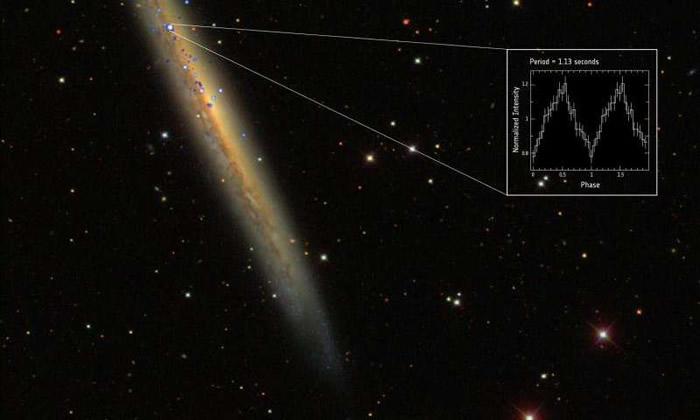The Brightest Pinning Pulsar Has Been Found
ESA’s XMM-Newton has found the spinning remains of a once-massive star – a pulsar – that is a thousand times brighter than previously thought possible.
The pulsar is also the most distant of its kind ever detected, with its light travelling 50 million light-years before being detected by XMM-Newton.
Pulsars are spinning, magnetised neutron stars that sweep regular pulses of radiation in two symmetrical beams across the cosmos. If suitably aligned with Earth these beams are like a lighthouse beacon appearing to flash on and off as it rotates. They were once massive stars that exploded as a powerful supernova at the end of their natural life, before becoming small and extraordinarily dense stellar corpses.
This X-ray source is the most luminous of its type detected to date: it is 10 times brighter than the previous record holder. In one second it emits the same amount of energy released by our sun in 3.5 years.
XMM-Newton observed the object several times in the last 13 years, with the discovery a result of a systematic search for pulsars in the data archive – its 1.13s periodic pulses giving it away.
The signal was also identified in NASA’s Nustar archive data, providing additional information.
“Before, it was believed that only black holes at least 10 times more massive than our sun feeding off their stellar companions could achieve such extraordinary luminosities, but the rapid and regular pulsations of this source are the fingerprints of neutron stars and clearly distinguish them from black holes,” says Gian Luca Israel, from INAF-Osservatorio Astronomica di Roma, Italy, lead author of the paper describing the result published in Science this week.
The archival data also revealed that the pulsar’s spin rate has changed over time, from 1.43s per rotation in 2003 to 1.13 s in 2014. The same relative acceleration in Earth’s rotation would shorten a day by five hours in the same time span.
“Only a neutron star is compact enough to keep itself together while rotating so fast,” adds Gian Luca.
Although it is not unusual for the rotation rate of a neutron star to change, the high rate of change in this case is likely linked to the object rapidly consuming mass from a companion.
“This object is really challenging our current understanding of the ‘accretion’ process for high-luminosity stars,” says Gian Luca. “It is 1,000 times more luminous than the maximum thought possible for an accreting neutron star, so something else is needed in our models in order to account for the enormous amount of energy released by the object.”
The scientists think there must be a strong, complex magnetic field close to its surface, such that accretion onto the neutron star surface is still possible while still generating the high luminosity.
“The discovery of this very unusual object, by far the most extreme ever discovered in terms of distance, luminosity and rate of increase of its rotation frequency, sets a new record for XMM-Newton, and is changing our ideas of how such objects really ‘work’,” says Norbert Schartel, ESA’s XMM-Newton project scientist.
More information: Phys.org


